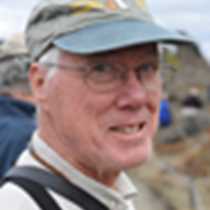Sorgfjord
Polar bear on shore! Polar Bear on shore!
But I get ahead of myself. During the night (while the midnight sun shone brightly), we rounded the northernmost point of the large island of Spitsbergen to reach Sorgfjord (The Bay of Sorrows.) It is a place rich in Svalbard history, dating back to the whaling era of the 17th century and continuing into the 20th century. Once the bays and fjords around Svalbard teemed with bowhead or Greenland Right whales. Soon after the discovery of Spitsbergen in 1596, whaling ships from Holland, England, France, Denmark, and Hamburg plied the waters to take the whales and their valuable oil. We see the remains of their shore stations and the bones of their prey scattered about Svalbard. It was not always peaceful coexistence among the whalers. In 1693, with warfare raging among European nations, France sent a small fleet of warships to harass enemy whaling ships (which is to say, all of them). Here in Sorgfjord a major sea battle took place between the French warships and Dutch whalers, with 11 Dutch ships taken captive (and their catch of whale oil taken) and 2 sunk. There is a whaler's graveyard from that period of Svalbard history here. Apparently, the Dutch used it is a burial ground for deceased whalers.
We landed on a gravel beach and spread out in our walking groups, looking down on a lonely Norwegian trapper's hut, built from the remains of a Swedish scientific station from 1899-1900, under a wooden cross erected in 1855, and on it goes. Brilliant purple saxifrage appeared in an otherwise lichen-dominated landscape. We watched three Svalbard reindeer moving quickly on a beach strewn with driftwood below us. One guest raised his binoculars, and reported quickly that the reindeer he was watching was, in fact, a polar bear. So the honor of sighting the first polar bear of our trip belongs to a guest; well done! We like to see polar bears, but we do not like to share a landing with them. The decision was quickly made to abandon the beach to the polar bear, and an orderly departure ensued.
Lagøya
We moved farther northward to the Island of Lagøya ("...øya" in Norwegian means island), where a summer haul-out of walrus is found. This is not a breeding site or colony. Females and pups are elsewhere, mainly on the east coast of Svalbard and on Russian Frans Josef Land even farther east. Males take no part in rearing the young. Lagøya is an area where males gather to hang out between feeding excursions (the better to acquire their impressive mass), and to molt their fur (for, as mammals, they do have a fur coat). Walrus are among the most social of mammals. They gather on land in big heaps, each walrus in contact with numerous close neighbors. Occasionally a squabble will break out, but a few quick pokes with the huge tusks restores peace and they return to what they do best when on land, which is not very much. They seem huge (at up to two tons, that word does apply) and ungainly on land, but in the water, still swimming side-by-side with neighbors, they are the picture of blubbery grace and agility. We used our Zodiacs for close-up encounters with the walrus, groups all around us. It was truly an Arctic moment, and it felt every bit of that, and then we returned to National Geographic Explorer to warm up with a cup of chocolate, with or without additive.




